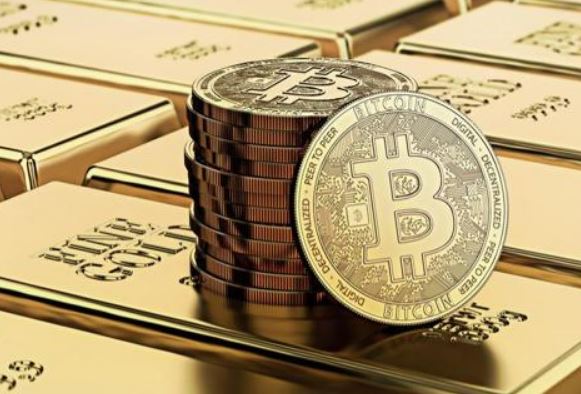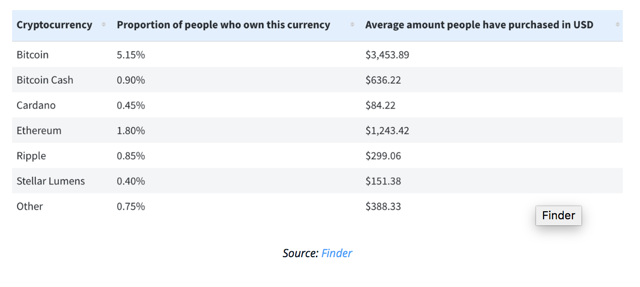Bitcoin: An Extraordinarily Scarce Commodity

The debate about what Bitcoin (BTC-USD) actually is from the U.S.’s regulatory standpoint is finally over. The Commodity Futures Trading Commission (CFTC) recently officially classified Bitcoin as a commodity, which essentially means it assumes regulatory responsibility over the digital asset.
So, why is this significant you ask? Well, now that Bitcoin is officially classified as a commodity, it is likely only a matter of time before various Bitcoin-backed ETFs and Bitcoin-related ETNs are introduced by various instructions. This should enable Bitcoin to become a widely traded investment vehicle on a worldwide scale.
Moreover, there are not that many Bitcoins around relative to other commodities, and its supply is ultimately capped at just 21 million. Additionally, unlike other commodities, Bitcoin can be used as a currency globally. Therefore, as worldwide popularity and demand accelerates, Bitcoin’s price is very likely to go much higher over the next few years.
If Bitcoin is a Commodity, it’s an Extremely Scarce One
There are currently about 17,307,500 Bitcoins that exist in total. This means that about 80% of all Bitcoins that will ever exist have already been mined. Also, fewer and fewer of the 3,692,500 unmined Bitcoins will be coming online between now and the estimated year 2140, when the last Bitcoin is expected to get mined.
Furthermore, the top 100 richest Bitcoin addresses show a concentration of nearly 3.4 million Bitcoins. This suggests that just 100 people, possibly fewer (due to possibility of multiple addresses owned by one user) control about 23% of all Bitcoins in circulation right now.
Why is all this important? Because, as Bitcoin becomes more popularized as a coveted and scarce commodity in the future, retail and institutional investors alike will rush into the market, and will quickly realize that there are far fewer Bitcoins to go around than most people had anticipated.
Fewer Bitcoins are Available for Trade
Just because there will be around 15 million Bitcoins in “circulation” does not mean that these Bitcoins will be available for trade. Many people HODL, and will continue to HODL for many more years. It’s difficult to quantify, but there are certainly far fewer Bitcoins available for trade on exchanges at any given time than the actual number of Bitcoins in existence or in circulation.
If you factor in an estimate for all the Bitcoins being HODLed, being reserved for future commercial transactions, being amassed as store of value instruments, held on cold storage devices, paper wallets, and other non-exchange storage platforms, likely a relatively small percentage of Bitcoins, perhaps 10-20% or so are available for trade on exchanges at any given moment. This implies that maybe about 1.5-3 million Bitcoins are available for trade at any given moment.
Naturally, once the price goes up substantially, more Bitcoins will come onto exchanges and the dynamic may change a bit. But the point is that there are very few Bitcoins available for trade relative to rapidly increasing demand.
Also, if we look at Bitcoin’s trading volume, it is still incredibly low. In the last 24 hours, fewer than 50K Bitcoins were traded in the entire world. In the last week, only about 400,000 were traded, and if we look back at the past month, fewer than 2 million Bitcoins were traded in the entire world. So, with approximately 13.5 million Bitcoins currently in circulation, only about 2 million were traded in 30 days. That is not a lot of volume, and it suggests that once institutional money and an increased number of retail investors rush into the market, prices will likely skyrocket.
In my view, there are essentially two types of people right now. Those who understand Bitcoin; in other words, believe that it will be a lasting and crucial component of the future digital financial system. And those who don’t see the significance of Bitcoin yet, but will likely be introduced to its importance relatively soon.
It is very likely that in the near future waves of institutional and retail buyers will enter the Bitcoin market and will drive prices significantly higher from current levels. Here is why:
Very Few People Own Bitcoin, But More Young People
According to a recent study, only about 5% of Americans own any Bitcoin. Now, America is the largest, and one of the most progressive and accepting markets for Bitcoin, yet roughly 95% of Americans have no exposure to it, yet. It is important to note that numbers are much higher amongst millennials, with nearly 20% having bought cryptos.
Source: CoinTelegraph.com
This suggests that younger people are likely the early adopters and could become lifelong users of Bitcoin, and cryptocurrencies in general. As this trend progresses, larger percentages of millennials, and of the overall population will likely become exposed to Bitcoin.
Also, statistics point to an average Bitcoin investment of about $3,453 amongst Americans. This suggests that the 5% of Americans who own Bitcoin may actually own about 8 million of them. This is almost 50% of all existing Bitcoins, owned by a very concentrated percentage of the U.S. population.
So, what will happen when the remaining 95% of Americans decide they want to own some Bitcoin? Or a portion of the remaining 99.8% of the world’s population decide they want to own Bitcoin?
This is another illustration of just how scarce Bitcoin is as a commodity, and as more institutions and individuals decide to own Bitcoin in the future, its price is very likely to appreciate rapidly.
Bitcoin: Officially a Commodity
So, the CFTC has officially recognized Bitcoin as a commodity, but what does this mean to investors? Possibly the most crucial implication is that a Bitcoin ETF, or likely a series of Bitcoin-backed ETFs and Bitcoin-related ETNs are only a matter of time of now. One of the reasons the SEC has been skeptical about approving Bitcoin-related ETFs is because of regulatory concerns. Well, now that Bitcoin is officially under the CFTC’s regulatory umbrella, the SEC is far likelier to begin approving Bitcoin ETFs going forward.
Implications of a Bitcoin ETF
The implications of widely adopted and easily traded Bitcoin ETFs are vast. Firstly, many investors don’t have easy access to Bitcoin right now. To own actual Bitcoin, you need to create an account on a cryptocurrency exchange, purchase Bitcoin, take additional steps to store it safely, and so on. Since this is all a relatively new phenomenon, many people don’t trust crypto exchanges, and some likely don’t understand, or even want to understand the entire process.
Some investors can trade Bitcoin via futures contracts. But once again, most retail investors and everyday people don’t trade futures contracts. Also, Bitcoin futures trade fewer than or around 1,000 contracts per day, which is miniscule compared to other commodities like gold, which traded over 250,000 contracts last Friday, or even silver which traded around 60,000.
Therefore, it seems that many market participants are forced to miss out on the Bitcoin opportunity. What is the answer to this problem? Bitcoin ETFs. This is why VanEck and many other prominent ETF providers are pushing the SEC to approve multiple Bitcoin-backed ETFs. Recently, the head of digital asset strategy at VanEck reiterated that the company’s commitment to bring a liquid, insured and appropriately regulated physically backed ETF was resolute. VanEck’s proposal for a physically backed Bitcoin ETF is only one of nine proposals being brought forth to the SEC at this time.
Bitcoin-Backed ETFs Require Bitcoins
The thing about physically backed Bitcoin ETFs is that the fund needs to buy Bitcoins. Once again, the problem is that there are not that many Bitcoins to go around. For instance, the Grayscale Bitcoin Investment Trust (OTCQX:GBTC), which is the nearest thing in the U.S. to a Bitcoin ETF, owns roughly 200,000 Bitcoins in its trust. We can probably expect VanEck and other ETF providers to use similar allocation sizes when building their funds as well.
So, essentially for every physically backed Bitcoin ETF that we see coming online, we can probably expect about 200,000 Bitcoins to be bought up by the fund. This effectively takes additional Bitcoins out of circulation. So as soon as ETFs start becoming approved, expect Bitcoin’s price to start moving much higher.
However, increased demand due to increased institutional ownership, ETF rollouts, and more overall demand from a commodity standpoint is just part of the equation. Expect demand increases from a functional, medium of exchange aspect as well.
Very Few People Use Bitcoin Today, But More Could Use It Tomorrow
Despite the deafening Bitcoin noise at the end of last year, still very few people around the world use Bitcoin. A recent study performed by University of Cambridge found that only around 3 million people worldwide are using Bitcoin on a regular basis. This is only about 0.04% of the world’s entire population. This gives you an idea of how early in the Bitcoin/cryptocurrency cycle the world is still in right now.
However, an increasing number of forward looking companies are already accepting Bitcoin as a legitimate form of payment for countless products and services. Some of the most prominent names accepting Bitcoin include Microsoft (MSFT), Overstock.com (OSTK), Expedia (EXPE), DISH Network (DISH), Shopify (SHOP), and many others.
The unique thing about Bitcoin is that yes, Bitcoin is officially a commodity in the U.S., but it can also be used as a currency globally. Moreover, Bitcoin’s “official” classification varies from country to country, and nations like Great Britain, and many others, officially classify Bitcoin as a form of currency.
Bitcoin’s Price Should Go Much Higher Long Term
From a demand standpoint, Bitcoin is likely to benefit twofold. On the one hand, Bitcoin is a commodity, which is used as a store of value, is packaged in futures contracts and should soon see physically backed ETFs roll out. This should create significant demand from a store of value/trading vehicle standpoint.
Additionally, Bitcoin is classified and is used as a currency in many places. Furthermore, an increasing number of major corporations are starting to accept Bitcoin as a legitimate payment method for goods and services. This trend is likely to continue and should create further demand from a functional and transactional standpoint.
However, the supply of Bitcoins is extraordinarily limited. Most of the easy Bitcoins have been mined and the mining process becomes increasingly more difficult from here, essentially capping most of the supply at just 19 million in the next several years. Furthermore, lost Bitcoins, HODLers, and other factors subtract even more Bitcoins from the supply part of the equation.
Ultimately, there are not that many Bitcoins to go around, and even fewer available for trade on exchanges at any given moment. Therefore, as demand from institutional players as well as from retail investors picks up in the next bull cycle, Bitcoin’s price is very likely to go much higher from current levels.
Why Bitcoin is Different
Many commodities have elastic supply, meaning supply can increase or decrease relative to demand. Gold, silver, and most other commodities can be derived from the earth in a seemingly unlimited capacity. This phenomenon keeps prices in equilibrium. But Bitcoin is much different, unlike other commodities only a finite number can ever exist, and therefore its price has almost an unlimited capacity to appreciate over the years going forward.
Risks Do Exist
Unlike other traditional commodities that can be touched, smelt, consumed, or utilized, Bitcoin exists essentially as code in digital form, and can only be used in conjunction with the internet. Coupled with immense potential, significant risks also arise.
Detrimental Government Regulation
In my view, the number one long-term threat Bitcoin faces is detrimental government regulation or an all out Bitcoin ban. If major Bitcoin friendly governments like the U.S., E.U., Japan, South Korea, and others follow the footsteps of China and essentially make Bitcoin use and trading illegal, it could have catastrophic consequences for Bitcoin’s price. Demand would likely plummet and when demand for a commodity decreases so does its price, drastically at times. This seems unlikely due to the progressive steps taken in the U.S., E.U. and other areas concerning Bitcoin, but the threat does exist, especially if Bitcoin ever starts to seriously challenge the current fiat financial status quo.
Another risk factor is the concern that Bitcoin may never become a widely used transactional currency due to its issues with speed and scale. Yes, the Lightning Network (LN) promises to solve many of the issues associated with speed, cost, and scale, but there is no guarantee that the LN will become widely adopted, even over time.
Therefore, there is the risk that newer and more efficient digital currencies like LiteCoin, Bitcoin Cash and others will make Bitcoin somewhat obsolete as an actual medium of exchange for the masses.
Continued Security Breaches and Fraudulent Activity
Continued security breaches in the Bitcoin world concerning exchanges and individual wallets is a constant concern. If significant breaches continue, investors and users may start to lose confidence in the system and demand could decrease as a result.
Likewise for fraud cases. In an industry that is relatively loosely regulated, substantial fraudulent activity is a persistent risk. Just like with security breaches, when people get ripped off, it reflects poorly on the entire industry and demand along with prices can suffer.
One Million and One Cryptocurrencies
Another concern is the seemingly endless supply of new cryptocurrencies. There are now over 2,000 different cryptocurrencies listed on CoinMarketcap.com. The risk is that the market may become oversaturated with digital assets which could lead to a crash, or to a devaluation of many digital assets, including Bitcoin.
Loss of Interest Amongst the Masses
There is always the simple risk of loss of interest amongst the masses. There is a chance that Bitcoin will forever remain a niche phenomenon, a novelty, as JPMorgan’s Jamie Dimon puts it. In this case, Bitcoin may not experience substantial demand, and the price would very likely cascade much lower over time.
Bitcoin is Not for Everyone
The bottom line is that Bitcoin is not for everyone. I view it as an investment for people with a relatively high risk tolerance, and even then, maybe only 5-10% of a portfolio’s holdings should be allocated to digital assets.
Bitcoin is still a relatively new phenomenon and no one truly knows exactly how it is going to play out over the long term. The truth is that 10 years from now one Bitcoin could be worth $1 million, or it could be worthless, and given the number of uncertainties, neither outcome should really shock people.
If you enjoyed reading this article, hit the “Like” button, and if you’d like insight about my future ideas, press the “Follow” link. Thank you for taking the time to read my article, and I hope that the information was helpful!
Disclaimer: This article expresses solely my opinions, is produced for informational purposes only, and is not a recommendation to buy or sell any securities. Investing comes with risk to loss of principal. Please always conduct your own research and consider your investment decisions very carefully.
Want more? Want technical analysis, trade triggers, trading strategies, portfolio insight, option ideas, price targets, and much more? To learn how to best position yourself for a rally in Bitcoin, and to find out about other high alpha investments, please consider joining Albright Investment Group.
- Subscribe now and receive the best of both worlds, deep value insight coupled with top-performing growth strategies.
- Join and get access to FULL ARTICLES that include technical analyses, trade triggers, trading strategies, portfolio allocations, price targets, options ideas, and much more.
- Enjoy access to my best investment ideas, and trade alongside AIG’s top-performing core long portfolio that has outperformed the S&P 500 by about 73% over the past year.
- Take Advantage of the limited time 2-week free trial offer now and receive 20% off your introductory subscription pricing. Click here to learn more.
Disclosure: I am/we are long BTC-USD, BCH-USD, LTC-USD, XRP-USD, DASH-USD, ZEC-USD.
I wrote this article myself, and it expresses my own opinions. I am not receiving compensation for it (other than from Seeking Alpha). I have no business relationship with any company whose stock is mentioned in this article.












Responses